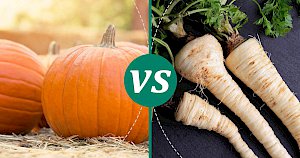Parsnips vs Pumpkin: Nutrition, Calories & Protein Compared


Parsnips vs Pumpkin
Nutrition Facts
Serving size:
change
5g10g15g20g30g40g50g60g80g100g120g140g160g180g200g220g250g300g350g400g450g500g600g700g800g900g1000g
1oz2oz3oz4oz5oz6oz7oz8oz10oz12oz15oz20oz25oz30oz35oz40oz50oz
Amount Per Serving:
Serving size:
change
5g10g15g20g30g40g50g60g80g100g120g140g160g180g200g220g250g300g350g400g450g500g600g700g800g900g1000g
1oz2oz3oz4oz5oz6oz7oz8oz10oz12oz15oz20oz25oz30oz35oz40oz50oz
Amount Per Serving:
Parsnips vs Pumpkin 100g Compare
| per 100g | Parsnips | Pumpkin |
|---|---|---|
| Calories | 75 | 26 |
| Carbohydrates | 17.99 g | 6.5 g |
| Fat | 0.3 g | 0.1 g |
| Dietary fiber | 4.9 g | 0.5 g |
| Protein | 1.2 g | 1 g |
| Calcium | 36 mg | 21 mg |
| Iron | 0.59 mg | 0.8 mg |
| Magnessium | 29 mg | 12 mg |
| Phosphorus | 71 mg | 44 mg |
| Potassium | 375 mg | 340 mg |
| Sodium | 10 mg | 1 mg |
| Zink | 0.59 mg | 0.32 mg |
| Vitaminium B1 (Thiamine) | 0.09 mg | 0.05 mg |
| Vitaminium B2 (riboflavin) | 0.05 mg | 0.11 mg |
| Vitaminium B3 (Niacin) | 0.7 mg | 0.6 mg |
| Vitaminium B5 | 0.6 mg | 0.298 mg |
| Vitaminium B6 | 0.9 mg | 0.061 mg |
| Vitaminium B9 (Folic acid) | 67 mg | 16 mg |
| Vitaminium C | 17 mg | 9 mg |
| Vitaminium K | 22.5 µg | 1.1 µg |
Discover the Nutritional Gems: Parsnips and Pumpkin
When autumn rolls around, two vegetables often come to mind: parsnips and pumpkin. Both are celebrated for their versatility in the kitchen and their nutritional benefits. But how do they really compare? Let's delve into some fascinating facts about these seasonal favorites before we pit them against each other in a nutritional showdown.
The Humble Parsnip: A Root of Many Wonders
Parsnips, with their creamy white flesh, might look like carrots' paler cousins, but they pack a punch in terms of flavor and nutrition. Historically, before the widespread use of sugar, parsnips were used to sweeten jams and cakes in Europe. They are not just a root vegetable for soups and stews; when roasted, parsnips develop a sweet, almost nutty flavor that makes them a delightful side dish.
Pumpkin: The Icon of Fall
Pumpkin is arguably the emblem of autumn. From jack-o'-lanterns to pies, this versatile squash is ingrained in fall traditions around the world. But beyond its festive uses, pumpkin is a nutritional powerhouse. It's low in calories and high in vitamins, particularly vitamin A, which is crucial for eye health and immune function.
Nutritional Face-Off: Parsnips vs. Pumpkin
When it comes to choosing between parsnips and pumpkin, it's like deciding between two healthful options. But for those curious about the specifics, here's a closer look at their nutritional profiles:
- Calories: Parsnips have more calories per serving, with 75 calories, compared to pumpkin's modest 26 calories.
- Carbohydrates and Fiber: Parsnips also lead in carbohydrates, offering 17.99g, including 4.9g of fiber, while pumpkin provides 6.5g of carbs and 0.5g of fiber.
- Protein and Fat: Both vegetables are low in fat and provide a small amount of protein, making them great additions to a balanced diet.
- Vitamins and Minerals: Pumpkin steals the show with its high vitamin A content (7384 IU), thanks to its rich orange color. Parsnips, however, offer a broader range of minerals like magnesium, phosphorus, and potassium.
While parsnips are denser in calories and carbs, they are an excellent source of fiber and minerals. Pumpkin, on the other hand, is lower in calories and carbs but is an outstanding source of vitamin A.
Which One Should You Choose?
The choice between parsnips and pumpkin depends on your dietary needs and preferences. If you're looking for a low-calorie, vitamin A-rich option, pumpkin is your go-to. However, if you're in need of a fiber-rich, hearty vegetable that can stand in as a starchy side, parsnips might be your best bet.
In the end, both parsnips and pumpkin are nutritious options that offer their own unique benefits. Why not incorporate both into your diet this fall and enjoy the best of both worlds?
Remember, the key to a healthy diet is variety. So, don't hesitate to explore the wide world of vegetables, including these two autumn favorites, to enrich your meals and boost your nutrition.
Parsnips 100g
75kcalCalories source
- 91% CARBS.
- 6% PROTEIN
- 3% FAT
Pumpkin 100g
26kcalCalories source
- 84% CARBS
- 13% PROTEIN
- 3% FAT
Compares of parsnips
- Parsnips vs Asparagus
- Parsnips vs Bamboo Shoots
- Parsnips vs Beetroot
- Parsnips vs Butternut Squash
- Parsnips vs Carrot
- Parsnips vs Cassava
- see all compares of parsnips
Marcin Piotrowicz
calories-info.com creator
Healthy diet and healthy lifestyle promoter
Add comment